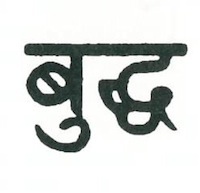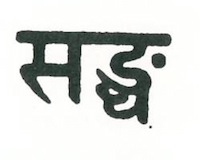

BUDDHA. From the Sanskrit root budh, literally “to wake, wake up, be awake.” Sanskrit was the elite language of the Aryan tribes whomigrated to South Asia sometime in the second millennium B.C.E. Various forms of this root, budh, appear in the oldest Sanskrit literature of the Vedas, the sacred texts of the Aryans (c. 2nd to 3rd millennia B.C.E.). The original form of the term was also meant to imply the recovery of consciousness (as after a swoon), or to become aware, etc. The adjective buddha is found already in the epic texts of the Mahabharata, the Indian equivalent to the Odyssey, with the meaning “intelligent, wise, learned.” The Buddhist name Buddha meaning an “awakened one” refers especially to Shakyamuni, a prince of the Shakya tribe and the founder of “Buddhism.” But apparently the Buddha was not referred to as “Buddha” by his followers and students during his lifetime; rather, he was generally called “Bhagavat”, or “Lord.”
DHARMA. Ultimately derives from the root dhri, “to bear, to support.” The Buddhist understanding of dharma as the “teaching” is related to the sense of
dharma as it appears in the Vedas in its older form, dharman: that which is firm, a steadfast decree, statute, law; practice, duty; morality, religion, good works, etc. The principal usage of the word dharma in India is connected to the idea of duty or even sacred duty as it relates to caste. In the simplest terms, the Buddha, for example, was a member of the ksatriya caste, the warrior and ruling caste, and as such his caste duty was to fight or to rule or to govern. Hinduism is often referred to as the sanatana dharma, the eternal dharma, which as such encompasses the various schools and lines of Hinduism. Hence, the Buddhist usage of dharma, meaning the Buddha’s law, doctrine, or teaching is in line with the traditional usage of the term.
 SANGHA. Derives from the prefix sam- (“with”) and the root han.Han has various meanings, but in this combination it means “contact.” Thus pre-Buddhist texts refer muni-sangha, a “gathering of sages.” The term is generally used to refer to people who had contact with others for a certain purpose. The collective body of Buddhists (especially the monks and nuns of early Buddhism) is referred to as the Sangha, a group who had contact with one another because of their shared aspiration to follow the Buddha’s dharma. Initially the Buddha seems to have envisioned a universal Sangha, but the monastic movement ended up as various separate “sanghas.” Today “the Sangha” refers generally to the collective body of individuals who follow the Buddhist teaching.
SANGHA. Derives from the prefix sam- (“with”) and the root han.Han has various meanings, but in this combination it means “contact.” Thus pre-Buddhist texts refer muni-sangha, a “gathering of sages.” The term is generally used to refer to people who had contact with others for a certain purpose. The collective body of Buddhists (especially the monks and nuns of early Buddhism) is referred to as the Sangha, a group who had contact with one another because of their shared aspiration to follow the Buddha’s dharma. Initially the Buddha seems to have envisioned a universal Sangha, but the monastic movement ended up as various separate “sanghas.” Today “the Sangha” refers generally to the collective body of individuals who follow the Buddhist teaching.